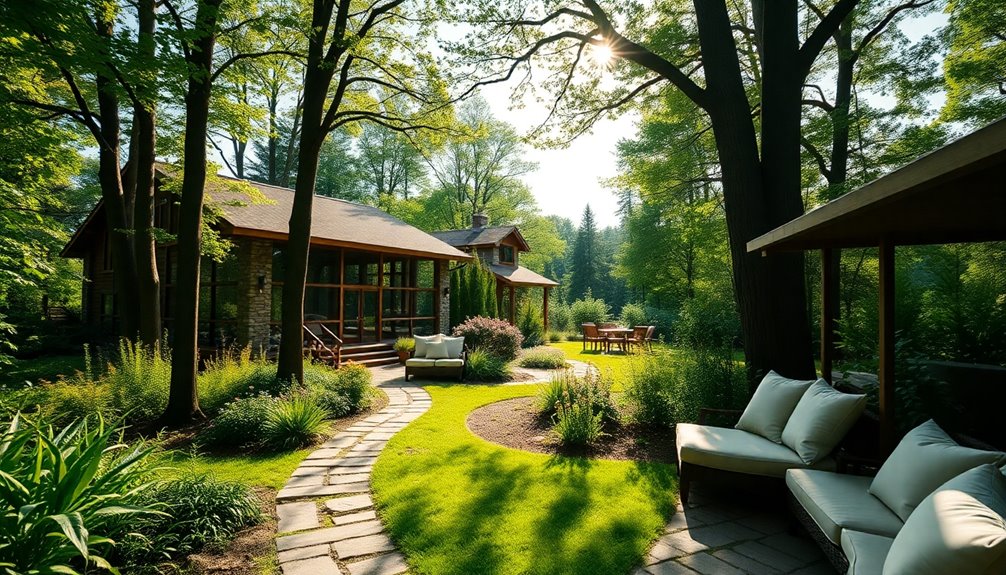To design a successful retreat center, focus on natural light and flexible spaces. Use large windows to boost mood, and adaptable furniture for various activities. Incorporate accessibility features for inclusivity, ensuring everyone feels welcome. Outdoor areas can connect participants with nature, providing serene spots for relaxation or meditation. Ultimately, invest in comfortable, ergonomic furniture to enhance engagement. By prioritizing these elements, you'll create a rejuvenating environment that fosters deep connections among participants. Explore more essential tips together.
Key Takeaways
- Maximize natural light with large windows and skylights to enhance mood and productivity.
- Design flexible spaces with movable walls and multi-purpose furniture for varied activities and deeper connections.
- Incorporate accessibility features like ramps and clear pathways to foster an inclusive environment for all participants.
- Create serene outdoor areas with gardens and seating for relaxation, meditation, and group discussions.
- Invest in comfortable, ergonomic furniture to support participant engagement and ensure comfort during long sessions.

Designing a retreat center that fosters relaxation and reflection requires careful consideration of various elements. One of the most important aspects is guaranteeing your space is filled with natural light. Research shows that environments rich in natural light enhance mood and productivity, making it essential for creating a calming atmosphere. Large windows, skylights, and open designs can help you achieve this. By prioritizing natural light, you're setting the stage for a rejuvenating wellness retreat where participants feel energized and relaxed.
Flexible spaces are also significant in your retreat center design. These adaptable areas allow you to cater to various activities, whether structured workshops, yoga sessions, or informal gatherings. By incorporating movable walls and multi-purpose furniture, you can create environments that meet diverse participant needs and preferences. This flexibility not only enhances the overall experience but also encourages engagement among participants, allowing them to connect more deeply with each other.
Accessibility features should be an integral part of your design process. Ramps, accessible restrooms, and clear pathways guarantee that all participants can comfortably navigate your retreat center, fostering an inclusive environment. When everyone feels welcome and accommodated, it enriches the overall experience and promotes a sense of community. Remember, a truly successful retreat center is one where everyone can participate fully.
Creating outdoor areas is another key consideration. Research indicates that spending time in nature greatly reduces stress and enhances well-being. By designing spaces for activities like meditation, group discussions, or simply relaxing, you provide participants with opportunities to connect with the natural surroundings. Incorporating gardens, walking paths, or even outdoor seating can transform your retreat center into a peaceful oasis.
Lastly, investing in comfortable furniture is crucial for participant engagement and satisfaction. Ergonomic chairs and supportive seating arrangements will help participants feel at ease during long sessions. When they're comfortable, they're more likely to engage actively and absorb the material presented. The right furniture supports the overall wellness experience, allowing participants to fully immerse themselves in the retreat. Additionally, considering proper insulation and sealing can enhance the comfort by maintaining an ideal indoor climate throughout the seasons.
Frequently Asked Questions
What Is the Ideal Location for a Retreat Center?
The ideal location for a retreat center depends on the atmosphere you want to create.
You'll want to evaluate serene environments, like mountains or lakesides, which foster relaxation and reflection. Accessibility is key, too—make sure your site's easy for attendees to reach.
Think about nearby amenities, like hiking trails or meditation spaces, that enhance the experience.
Ultimately, choose a spot that resonates with your vision and encourages peace and rejuvenation.
How Do I Market My Retreat Center Effectively?
Did you know that 70% of travelers seek wellness experiences?
To market your retreat center effectively, use social media platforms to showcase your unique offerings. Create engaging content with beautiful images and testimonials from past guests.
Collaborate with influencers in the wellness community and offer promotions to attract new clients.
Don't forget to optimize your website for search engines, making it easy for potential guests to find you and learn more about your services.
What Permits Are Needed to Build a Retreat Center?
When building a retreat center, you'll need several permits.
Start by checking local zoning regulations to guarantee your land is suitable for this purpose.
You'll likely need a building permit, environmental permits, and possibly special use permits if you're operating a business.
Don't forget to consult with your local planning department—they'll guide you through the process and help you understand all requirements specific to your area.
How Can I Ensure Accessibility for All Guests?
To guarantee accessibility for all guests, start by evaluating your space for wheelchair access, including ramps and wide doorways.
Install grab bars in restrooms and provide accessible seating.
Consider sensory-friendly spaces for guests with sensory sensitivities.
Offering materials in various formats, like Braille or large print, can also help.
Finally, train your staff to assist guests with different needs, guaranteeing everyone feels welcomed and included during their stay.
What Types of Activities Should I Offer at My Retreat Center?
Imagine your retreat center as a garden, where diverse activities bloom like vibrant flowers.
You'll want to offer a mix of wellness sessions, creative workshops, and nature excursions to nurture every guest's spirit. Think yoga classes, art therapy, and guided hikes.
Each activity should cater to different interests, allowing everyone to cultivate their personal growth.
Conclusion
In designing your retreat center, remember that the environment you create can greatly impact your guests' experiences. Did you know that 70% of retreat attendees report a boost in well-being after just a weekend away? Imagine transforming your space into a sanctuary that fosters relaxation and rejuvenation. By incorporating thoughtful design elements and focusing on nature, you'll not only attract more visitors but also help them leave feeling refreshed and inspired. Your vision can become their oasis.









